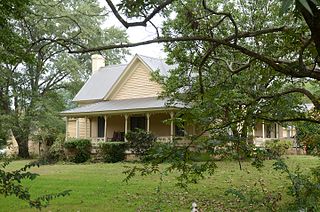
U.S. Route 64 is a U.S. highway running from Teec Nos Pos, Arizona east to Nags Head, North Carolina. In the U.S. state of Arkansas, the route runs 246.35 miles (396.46 km) from the Oklahoma border in Fort Smith east to the Tennessee border in Memphis. The route passes through several cities and towns, including Fort Smith, Clarksville, Russellville, Conway, Searcy, and West Memphis. US 64 runs parallel to Interstate 40 until Conway, when I-40 takes a more southerly route.

Arkansas Highway 365 is a north–south state highway in Central Arkansas. The route of 69.31 miles (111.54 km) runs from US 65B/US 79B in Pine Bluff north through Little Rock to US 65B/AR 60 in Conway. The route is a redesignation of former U.S. Route 65, which has since been rerouted onto various Interstate highways through the area. Portions of Highway 365 in Jefferson County are former alignments of the Dollarway Road, which was the longest paved concrete road upon completion in 1913.

U.S. Route 62 is a U.S. highway running from El Paso, Texas northeast to Niagara Falls, New York. In the U.S. state of Arkansas, the route runs 329.9 miles from the Oklahoma border near Summers east to the Missouri border in St. Francis, serving the northern portion of the state. The route passes through several cities and towns, including Fayetteville, Springdale, Bentonville, Harrison, Mountain Home, Pocahontas, and also Piggott. US 62 runs concurrent with several highways in Arkansas including Interstate 49 and U.S. Route 71 between Fayetteville and Bentonville, U.S. Route 412 through much of the state, U.S. Route 65 in the Harrison area, and with U.S. Route 63 and U.S. Route 67 in northeast Arkansas.

Highway 38 is a designation for three state highways in Arkansas. One route of 49.58 miles (79.79 km) runs east from Highway 367 at Cabot to US Route 49 (US 49) near Hunter. A second route of 21.43 miles (34.49 km) begins at Interstate 40 (I-40) and runs east to Highway 147 near Horseshoe Lake. A third route of 0.10 miles (0.16 km) runs in West Memphis as Martin Luther King Jr. Drive from US 70 north to I-55/US 61/US 64/US 79. All routes are maintained by the Arkansas State Highway and Transportation Department (AHTD).

Highway 31 is a north–south state highway in Central Arkansas. The route of 75.34 miles (121.25 km) runs from U.S. Route 79B (US 79B) near Pine Bluff north across US 165, US 70, Interstate 40 (I-40) and US 64/US 67/US 167 before terminating at Highway 5 near Romance.
Indian Bay is an unincorporated community and census-designated place (CDP) in southern Monroe County, Arkansas, United States, in the Arkansas Delta. Indian Bay is on the eastern bank of the White River, 4 miles (6 km) east of St. Charles. For purposes of the U.S. Census, Indian Bay is within Montgomery-Smalley Township. The Baytown Site, a Pre-Columbian Native American archaeological site, is located near Indian Bay. The community was first listed as a CDP in the 2020 census with a population of 15.

Judd Hill is an unincorporated community in Poinsett County, Arkansas, United States. Judd Hill is located on Arkansas Highway 214, 5 miles (8.0 km) south of Trumann. The Judd Hill Cotton Gin, which is listed on the National Register of Historic Places, is located in Judd Hill. Judd Hill was named for banker and businessman Orange Judd Hill, who founded the community.

The Kemp Cotton Gin Historic District encompasses the only cotton gin extant in the Rohwer area of Desha County, Arkansas. The gin was built in 1950 by O. O. Kemp, a few years after the closure of the Rohwer War Relocation Center, where as many as 10,000 Japanese-Americans were interned during the Second World War. After the center's closure much of its land was returned to agricultural use, and Kemp built this gin near the Missouri Pacific Railroad line that ran through Rohwer. In addition to the gin, the complex Kemp built includes a pump house, scale house, and office. This entire complex was listed on the National Register of Historic Places in 2005.

The Womack–Parker House is a historic house off Arkansas Highway 4 in Nashville, Arkansas. The house is notable for its age, its association with one of Nashville's leading businessmen, and for its distinctive architecture. The house is a single block of wood-frame construction with a central hall plan. It has porches with decorative jigsaw woodwork on three sides. Its construction date is uncertain, but it was purchased in 1878 by David Womack and extensively altered. Womack arrived in Howard County in 1849, and operated a highly successful array of businesses, including a lumber mill, and a cotton gin. The property on which the house stands also includes a variety of 19th-century log structures.

The John H. Johnston Cotton Gin Historic District encompasses a historic cotton gin in the small community of Levesque, Arkansas. The main building of the gin was built in 1941, and was built out of reinforced concrete, instead of the more usual steel, owing to a metal shortage in World War II. It has some Moderne styling, with smooth surfaces and rounded corners. The gin also distinctively incorporates a seed storage facility at its rear. Its ancillary structures, which include a shed, privy, and cyclone structure, are wood-framed with metal siding and roofing.
The Ackins House was a historic house in Floyd, Arkansas. Located on the east side of Arkansas Highway 31 just north of its intersection with Arkansas Highway 305, it was one of the small number of early houses to survive in White County at the time it was listed as a historic site.

The Hanger Cotton Gin is a historic cotton gin in Sweet Home, Arkansas. Built about 1876, it is a rare surviving example of a steam-powered gin. The main building is a three-story frame structure covered in board-and-batten siding. The gin was only operated commercially for a brief period, and was out of service by 1892. Since then, the building has been used as a barn and grain storage facility. It was probably built by Peter Hanger, whose family has been prominent in the Little Rock business community since that time.

The Darden-Gifford House is a historic house in rural White County, Arkansas, north of Arkansas Highway 5 near the community of Rose Bud. It is a two-story wood-frame structure, with a side gable roof, weatherboard siding, and a two-story porch sheltered by a projecting gable-roofed section. It was built in 1887 by J. S. Darden, a local sawmill owner, and was built using the choicest cuts from his mill, resulting in extremely fine quality woodwork. The house and 160 acres (65 ha) were sold by Darden in 1908 to J. S. Gifford, and was sold to a Priscilla Stone.
The Morris Institute Dairy Barn was a historic barn in rural White County, Arkansas. It was located on the campus of the Morris Institute, northwest of Searcy off Arkansas Highway 320. It was a two-story wood-frame structure, with a gable roof that was extended over a single-story extension on one side. Its internal arrangement was unusual, with a central drive that was intersected at one point by another drive extending into the shed section. Built about 1930, it was the county's best example of a Depression-era dairy barn.

The Keo Commercial Historic District encompasses a cluster of commercial and industrial buildings that make up the economic center of the small city of Keo, Arkansas. The district includes a two-block section of Main Street, anchored at its southern end by the Cobb Cotton Gin complex, and on the north by Arkansas Highway 232, where it extends a short way in both directions. The community grew around the Cotten Belt Railroad line, which Main Street was laid out just west of. The cotton gin complex has its origins in 1906, as a means for local farmers to process their cotton and send it on to market via the railroad.
The A.J. Smith House was a historic house on Arkansas Highway 385 in Griffithville, Arkansas. It was a two-story wood-frame structure, with a T-shaped gable-roofed structure, weatherboard siding, and a foundation of brick piers. A hip-roofed porch extended across the front of the projecting T section and around the side. The house was built about 1887, and was one of White County's few surviving 19th-century houses.

The Stipe Cotton Gin is a historic cotton gin at Florida and Cypress Streets in Beebe, Arkansas. It is a two-story steel-framed structure, clad in corrugated metal, that houses the steam compressor and other equipment for processing and baling cotton. The complex also includes a seed storage building, and a circular structure of uncertain function. Built about 1930, it is one of only five to survive in White County from that period, when cotton production was locally at its peak.

The Walker Homestead Historic District encompasses a collection of related agricultural and homesteading properties in rural White County, Arkansas. Located on Gum Spring Road about 1 mile (1.6 km) east of Arkansas Highway 267 southwest of Searcy, the district includes two farmstead houses, a barn, tenant housing, cotton gin, and other features. The oldest portion of the oldest house is a single pen log structure built about 1850 by William Walker, one of the area's early settlers, while the other house is a c. 1900 vernacular Greek Revival structure built by Billy Walker, Sr. The district encapsulates a typical evolutionary history of rural properties in the region, and was listed on the National Register of Historic Places in 1992.

The Burton Farmers Gin is a 2- and 3-story cotton gin house located close to the commercial district of Burton, Texas. It has also been known as Burton Farmers Gin Association's Site No. 3. It was listed on the National Register of Historic Places in 1991. It hosts the Texas Cotton Gin Museum. Besides the gin, the museum includes cotton warehouses and a shoe shop.

The Piazza Cotton Gin is on the Frogmore Plantation at 11656 U.S. Highway 84, about 7 miles (11 km) west of Ferriday, Louisiana in Concordia Parish, Louisiana. The building containing the cotton gin press was built c.1880, while the machinery was added c.1900. The gin itself is a system cotton gin, which was invented by Robert S. Munger. This invention was the second major revolution in cotton processing. This example is one of the few left in existence.


















